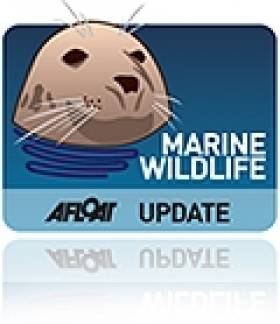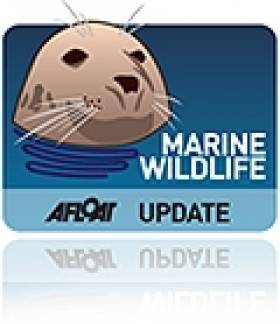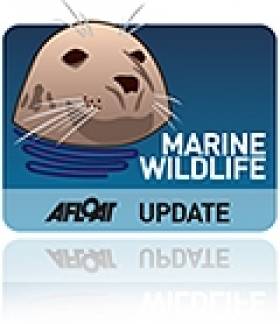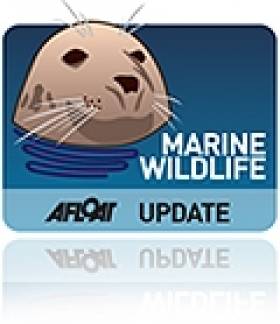Displaying items by tag: marine wildlife
Since the first report of the Humpback whale off Howth, north Co Dublin, on Thursday, the first sighting in the area in almost 20 years, several other eyewitness reports are surfacing too. The sitings are among a handful of validated recordings of the species in Irish waters over the past century.
A 10-year-old boy who was taking part in a Howth YC sailing course was afloat when the mammal surfaced on Thursday afternoon. The whale swam between the rescue boat and the young sailor as he waited to be picked up by an instructor.
Earleir this week Skerries Sailing Club spotted the humpback on Wednesday evening when preparing for its evening race.. "The whale was just astern of the committee boat which was anchored, said one official.
"The whale remained in close proximity to the boat for about 20-30 minutes and came to within touching distance of the boat," he added.
The mammal has been photographed within metres of the Cardinal marker off Howth Head, between Ireland's Eye and Howth harbour.
The photographer, Seán Pierce of Shearwater Sea Kayaking told reporters: "It stayed around Cardinal Mark off Howth for over two hours . . . lolling about pushing [its] head into trailing weed and perhaps scratching itself." he told the Irish Times.
The mammal has a preference for shallow coastal waters.
Fin Whales Spotted off Waterford
The first inshore Fin Whales of 2010 have been spotted off the Waterford coast, the Irish Whale and Dolphin Group have reported. The Fin Whale is the second largest animal on the planet, with only the Blue Whale larger. Fin whales can grow to 27 metres in length, and weigh up to 70 metric tonnes and live to nearly 100 years.
The Irish Whale and Dolphin Group carried out a whale watching session at Ram Head in Ardmore. The description that follows is from the IWDG website, which you can find here.
"With what looked like a brief window of opportunity we arrived yesterday evening 5th July at 19.40 to carry out one of our 100 minute effort watches at Ram Head, Ardmore, Co. Waterford. With sea conditions and visibility excellent, it seemed likely that if there was anything out there we’d have a good chance of seeing it.
Within half an hour Ann picked up on a "low puffy" blow about 8 km east-south-east of us. The animal proved to be extremely elusive and it was another 20 minutes before it was seen again as it headed towards the horizon. Yet again it disappeared and as Ann stayed watching the area where this whale was sporadically surfacing, I decided to continue my scan. There in the usual ‘hot spot’ for whale activity, due south of me was our first fin whale of the season. This animal was behaving in a much more reasonable manner. Three or four tall vapour plumes appeared in sequence as the whale steamed towards Capel Island.So, once again, as in several previous years, Ardmore has also proved to be the place to be to witness the arrival of the first of these welcome visitors to our coastline. Let’s hope they stick around a bit before heading along the coast to Cork!
We never secured an ID on the first whale, but considering that humpback (HBIRL3) also known as ‘Boomerang’ has twice before been seen in the same week in July in the same patch of water (15th July 2002 and 13th July 2008) might he have decided to visit us again this year?
As the weather window appears to have closed again it seems unlikely that we will get a chance to do a watch for a while so I guess we’ll never know!
Andrew Malcolm & Ann Trimble, IWDGEnergetic Atlantic Dolphins are Fussy Eaters
Atlantic Dolphins choose to eat high-energy fish to suit their energetic lifestyles, scientists have found.
A study of dolphins off the French coast shows that dolphins shy away from less calorie-dense prey in favour of high-energy food. This dispels a myth that dophins are opportunistic feeders that take any food that comes their way.
The study was carried out by Dr Jerome Spitz and other scientist at the University of La Rochelle in France, who looked at the eating habits of short-beaked common dolphins.
This species are the most common type of dolphin in nearby Atlantic waters. The team studied the stomach contents of dolphins caught accidentally in tuna drift nets to see what they ate. They then compared what they found in the dolphins' stomachs with what surveys of trawling fish catches indicated as plentiful in the same waters.
What they found was that dolphins actively select their prey based on its energy density, preferring deep-sea species like lanternfish instead of fish that have lower energy densities.
The dolphins studied turned their noses up at fish with under 5kJ of energy per gram, and sought out rarer breeds of fish that had a higher energy rate.
Two favourites were less common species of lantern fish, the Kroyer's lanternfish and the Glacier lanternfish which have 7.9kJ and 5.9kJ per gram respectively. Other less energetic predators, like sharks, are less fussy and take anything that's going.
Warm Water Species on the Increase Around Ireland’s Coasts
Mr. Sean Connick, T.D., Minister of State at the Department of Agriculture, Fisheries and Food, today (June 29th) launched a milestone report on the effects of climate change on Ireland’s marine ecosystems. The document - Irish Ocean Climate and Ecosystem Status Report 2009 – details a number of significant observations recorded in recent years including: increases in sea surface temperature, increased wave heights off the south west coast and an increase in the number of warm water species in Irish waters, ranging from microscopic plankton to swarms of jellyfish. This report is one of three projects funded as part of the Marine NDP Research Programme (Sea Change) under the Environmental Policy Research Measure.
“It could be argued that one of the greatest challenges our marine food industries - such as fishing and aquaculture - are the effects of marine climate change,” said Minister Connick. “These changes will be primarily driven by the Atlantic Ocean. Research is therefore urgently required to improve our capability to predict marine climate change so that we can preempt and deal with the economic, social, political and environmental consequences that might follow.”
One key finding of the report is that increases of sea surface temperature of 0.6°C per decade have been taking place since 1994, which are unprecedented in the past 150 years. This in turn is linked to an increase in microscopic plants and animals, along with species of jellyfish. Further up the food chain, increased numbers of most warm water fish species have been observed in Irish waters, along with sightings of exotic species such as snake pipefish. Declines in number of seabirds have also been observed which may have a climate link.
“Ireland is strategically placed to play a key role in monitoring ocean-induced changes in our climate and environment,” said Dr. Peter Heffernan, CEO of the Marine Institute. “Geographically the warm southern waters of the Atlantic drift come closer to Ireland than any other country in Europe, where they merge with the cooler northern waters off the coasts of Galway and Mayo. It is here that the predicted biological shifts in marine species diversity or abundance are most likely to occur, making Ireland an ideal laboratory for the study of marine climate change.”
In the long term, the Irish Ocean Climate and Ecosystem Status Report 2009 report predicts that global mean sea level may rise by up to 0.88 m by 2100. This, when combined with the increase in wave heights of 0.8 m that have already been observed off southwest Ireland, could lead to an increased threat of coastal erosion and flooding.
‘We assembled a team who extensively reviewed and analysed our extensive marine databanks on oceanography, plankton and productivity, marine fisheries and migratory species such as salmon, trout and eels with the specific aim of identifying any pattern that might be linked to climate change,” said Dr. Glenn Nolan of the Marine Institute who managed the team. “In some instances these data were painstakingly assembled over a considerable period of time, indeed one of the time series extends back over five decades.”
A second report which reviews the effect of ocean acidification in Irish waters “Ocean Acidification: An Emerging Threat to our Marine Environment - 2010” has also been completed which highlights the growing threat to marine life and fragile ecosystems around the coast as a direct consequence of increased carbon dioxide (CO2) levels in the atmosphere. The report recommends that a nationally coordinated multidisciplinary marine climate change and ecosystem monitoring programme be established that will enable better evaluations to be made of the threats posed to the marine environment and economy by ocean acidification. It emphasises closer links between climate change, ocean acidification and environmental policy development especially in relation to mitigation strategies to reduce carbon emissions.
Sea Change – A Marine Knowledge, Research & Innovation Strategy for Ireland, identified climate change as a priority area for research over the period 2007 to 2013 and this report represents a significant contribution towards achieving the objectives of the marine research programme. It addresses the need to increase our understanding of the drivers and regulators of climate so as to improve the accuracy of advice to Government while at the same time provide key inputs into the national climate change programme of the EPA. It will also improve the reliability of predictive models, and allow researchers to downscale global climate model predictions to the regional/local scale. As an island nation, it is important to continue to support investment in marine climate change research. This in turn will strengthen Ireland’s ability to develop knowledge-based scenarios on climate change impacts on the various marine sectors and include these in all future social, economic and environmental strategies.
The complete Irish Ocean Climate and Ecosystem Status Report 2009 and Report summary are downloadable from:
http://www.marine.ie/NR/rdonlyres/E581708D-6269-4941-836F-6B012DD7A4BD/0/IrishOceanClimateandEcosystemStatusReport2009.pdf
http://www.marine.ie/NR/rdonlyres/7528902D-2467-4F3E-BF21-39D81AEA4D37/0/SummaryIrishOceanClimateandEcosystemStatusReport2009.pdf
The Ocean Acidification Report can be downloaded from:
http://www.marine.ie/home/publicationsdata/publications/Marine+Foresight+Publications.htm
Satellite-Linked Tagging of Porbeagle Sharks
Scientists at the Marine Institute, Galway, are working with anglers around Ireland to study the migration and diving behaviour of porbeagle sharks (Latin name - Lamna nasus) in the northeast Atlantic. Porbeagle sharks are one of the top marine predators around Ireland, but very little is known about their movement patterns in the northeast Atlantic.
Like most pelagic sharks around the world, the porbeagle shark is vulnerable to fishing pressure due to its high commercial value, slow growth rate and complicated reproductive cycle. However, there is currently no protective legislation for the species, primarily due to a lack of basic information on its biology and ecology.
Marine Institute fisheries scientist Dr. Maurice Clarke said, "Understanding the biology and spatial ecology of the porbeagle shark is key to the conservation of the species and for establishing successful ecosystem-based management strategies in the northeast Atlantic".
To study the movement patterns of porbeagles, scientists are using pop-up satellite tags. These tags are fitted harmlessly to the back of the shark and collect information on the animals' location and depth distribution, together with data on the environment in which the sharks live. Then after nine months the tags pop-up to the surface and transmit the data to polar-orbiting satellites.
With help from expert shark angler, Peter McAuley, three tags were deployed off Downings, Donegal, in September 2008. These data have provided new insight into the migration and diving behaviour of porbeagle sharks around Ireland. One shark, a juvenile male, migrated over 2400 km to Madeira off the west coast of Morocco during the wintertime. Another shark migrated to the Bay of Biscay, a region that is considered a hotspot for other shark-like species such as albacore tuna. The results also showed that porbeagle diving behaviour is linked strongly to the day-night cycle and the monthly lunar cycle.
Daragh Brown of BIM commented that, "These results are really interesting and since there isn't a whole lot known about porbeagle behaviour or habitat preference, even small amounts of data can really advance our knowledge".
This year, Marine Institute scientists are hoping to tag large adult females to find out the location of porbeagle birthing grounds. Currently nothing is known about where these large predators give birth.
The Marine Institute is currently working with the Irish Elasmobranch Group, French Research Institute for Exploration of the Seas (IFREMER), and the Association for the Conservation of Sharks (APECS) to find further funding for the project that will end in 2011. They aim to establish links between the fishing industry, recreational anglers and the public to increase research and awareness for the conservation of these sharks.
Dr. Edward Farrell (Irish Elasmobranch Group) said, "Pelagic sharks have received much global attention recently. Given the increasing pressures that threaten their survival, there is a pressing need for new research to underpin effective management measures".
Irish Sea Jellyfish Survey continues
A four-year survey of jellyfish population and movements in the Irish Sea continues this summer, with the public being asked to report sightings of any jellyfish that they see on the water. The EcoJel project is a collaboration between UCC and Swansea University and aims to see whether jellyfish in the Irish Sea could be a potential resource, either as an export product to countries where jellies are a delicacy, or as an attraction for divers who enjoy diving with jellyfish blooms.
The survey also hopes to deepen understanding of jellyfish blooms, which have caused beach closures and fish kills in the Irish Sea in recent years.
For more information, or to report sightings, check out www.jellyfish.ie
Irish Seal Sanctuary Moves to Courtown
On Saturday May 1st, the Irish Seal Sanctuary made its last journey from Garristown in North Dublin to release three seals in Courtown’s North Beach, Co Wexford. The weekend marked the beginning of a new era for the ISS who are setting up a new head quarters in Courtown. Irish boaters play an important role in identifying and advising the seal sanctuary of stranded or injured seals around the Irish coast. More here
Useful links on this story:
http://www.irishsealsanctuary.ie/iss_via/html/main.htm
http://www.irishtimes.com/newspaper/ireland/2010/0503/1224269588723.html
Suspicion Grows Clam was Deliberately Introduced to the Barrow
The finding of “a well-established, high-density colony” of the freshwater Asian clam in the river Barrow at St Mullins, south Co Carlow, has alarmed fisheries officials and wildlife experts. Michael Parson has the full story in The Irish Times. Dr Joe Caffrey of the Central Fisheries Board said the invasive species posed a threat to salmon, trout and other native species such as the freshwater pearl mussel. The “invader” could damage the food chain in Irish rivers and fatally harm the gravel beds which are used by fish as spawning grounds.































































